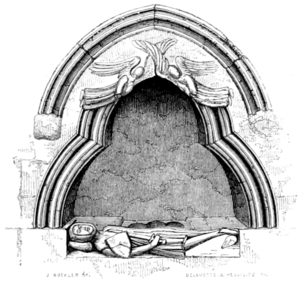PROCEEDINGS OF THE COMMITTEE.
257
with masonry, so that admission is utterly impracticable. It is presumed that the object of this construction was to preserve the walls from the damage to which they are exposed by visitors breaking off pieces of the Roman tiles. This end, however, has not been attained; for the parts exposed to the bad taste of the public are still unprotected, while the character of the structure is destroyed, and the antiquary prohibited from seeing its most interesting features.
Mr. Parker laid before the Committee a drawing of a curious combination of a piscina and monument in the church of Long Wittenham, Berkshire.

Piscina and Monument in Long Wittenham Church.
The monument is of diminutive size, the effigies of the knight being only two feet and two inches in length.
A note was read from Richard Sainthill, Esq., of Cork, to Mr. Smith, with pencil drawings in illustration of Irish ring-money. Mr. Sainthill remarks,—"Immense quantities of gold have been annually found in the bogs and other soils in Ireland, of a ring form, more or less perfect or circular, and various opinions have existed as to their original purpose. Most persons supposed them intended for ornaments. A few years since, Sir William Betham, Ulster king-at-arms, read a paper before the Royal Irish Academy, published in their Proceedings, and almost republished with the illustrations in the Gentleman's Magazine (not having my copy of Sir W. B.'s paper at home, I am prevented referring to its date). In this paper Sir William gave it as his opinion that these rings, which are most abundant in gold, then in copper, and very rare in silver, were money, and the smallest weight he had met with was of twelve grains, which will generally divide into the weights of all the larger; and several having lately come under my observation, I have found this to be the case. I have sent you tracings of nine silver rings, dug up near this city together in March, 1844; the weights of seven, which are perfect, are thus:—
408 grains, divided by 1234 grains ................................................................................................................................................................................................................................................................................................................................................................................................ |
|
768 do.64 ................................................................................................................................................................................................................................................................................................................................................................................................ |
|
600 do.50 ................................................................................................................................................................................................................................................................................................................................................................................................ |
|
372 do.31 ................................................................................................................................................................................................................................................................................................................................................................................................ |
|
372 do.31 ................................................................................................................................................................................................................................................................................................................................................................................................ |
|
324 do.27 ................................................................................................................................................................................................................................................................................................................................................................................................ |
|
384 do.32 ................................................................................................................................................................................................................................................................................................................................................................................................ |
|

